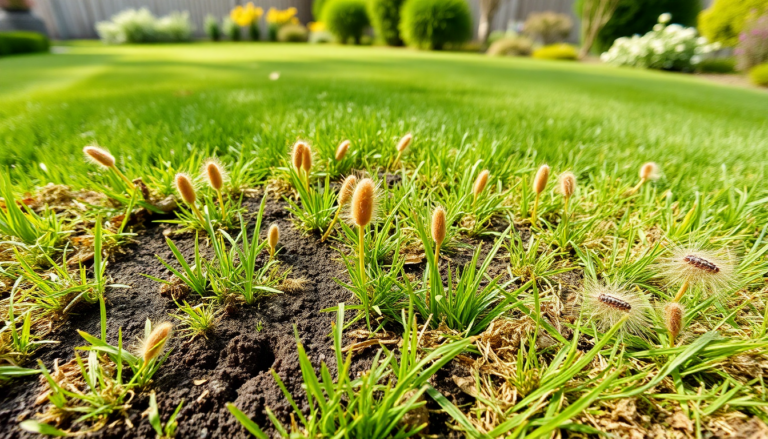Argomenti trattati
Picture this: you’ve spent hours nurturing your lawn, ensuring it’s green and lush, only to find it turning into a patchy, sad-looking mess. What gives? You might suspect drought or poor soil, but the real villains could be lurking beneath the surface—pests! As someone who has battled my fair share of lawn woes, I can tell you that identifying these pesky intruders is the first step toward reclaiming your green paradise.
Identifying the culprits: Common lawn pests
So, what pests should you be on the lookout for? Let’s dive into some of the most common offenders. First up, white grubs. These little critters are the larvae of various scarab beetles, and they can wreak havoc on your turf. You might notice your grass turning yellow or brown, and it may even feel loose enough to pull up easily. It’s like your lawn is giving up on life, and trust me, it’s not a good look. Wildlife like raccoons and skunks might even dig around your yard, feasting on grubs. I remember the time I woke up to find a raccoon digging in my yard—it was like a scene straight out of a wildlife documentary!
How to check for grubs
To see if grubs are the problem, grab a shovel and cut a one-foot square section of sod. Roll it back and look for those fat, C-shaped, white grubs. The adult beetles lay eggs in early summer, and the cycle continues with grubs feeding on grass roots until the cold weather sends them deeper into the soil. If you find them, a preventive insecticide in spring is your best bet—products containing chlorantraniliprole or imidacloprid are effective. And forget about bacterial milky spore products; they just don’t work, as I learned the hard way.
Chinch bugs: The silent destroyers
Next on our pest parade are chinch bugs. These tiny, 1/6-inch-long bugs love to hang out in dry conditions. You might not notice them at first, but they can devastate your grass in no time. One minute, your yard looks fine; two days later, it’s a crunchy brown mess. I can’t tell you how many times I thought my lawn was just thirsty, only to find out I had a full-on chinch bug invasion!
Spotting chinch bugs
To determine if chinch bugs are the culprits, you can use the flotation technique. Hammer a metal can into your lawn, pour some soapy water inside, and wait. If chinch bugs are there, they’ll float to the top like little black-and-white flags of surrender. When you see them, don’t wait! Apply a pesticide containing imidacloprid or bifenthrin right away.
Grass mites: Tiny but mighty
Then we have grass mites, which are sneaky little pests that often target warm-season grasses. They’re so small that you might need a magnifying glass to see them, but the damage they cause is noticeable. Your grass may look patchy or have a stunted appearance, like it’s trying to grow but just can’t catch a break. I once thought my lawn was suffering from some weird disease, only to discover it was mites causing the chaos!
Tackling grass mites
Identifying grass mites often requires help from a local university co-op service since they can be tricky. Sadly, there aren’t many registered miticides for these pests, but options like abamectin may help. Keeping your grass mowed at the right height and bagging infected clippings can also help reduce their impact.
Billbugs: The snout-nosed marauders
Now, let’s chat about billbugs. With their long snouts, they look like they belong in a cartoon! These pests can be hard to spot, but their larvae feed on grass stems and roots, causing telltale brown patches in your yard. When I first encountered them, I was baffled until I performed the “tug test”—if the grass pulls up easily, billbugs could be the issue.
Dealing with billbugs
Once you confirm you have billbugs, treat them like the unwanted guests they are with a white grub product. Look for active ingredients like chlorantraniliprole or imidacloprid, and follow the label instructions carefully.
Scales and mealybugs: The sneaky suckers
Finally, scales and mealybugs can also be the culprits behind ailing warm-season grasses. They might initially make your lawn look thirsty, but if left unchecked, they can cause serious damage. I recall a neighbor mistaking their lawn’s yellowing for a lack of water when it was actually these pesky little suckers at play!
Identifying and treating scales and mealybugs
Getting a positive ID is crucial. Systemic insecticides that are ingested during feeding are typically more effective. Look for products with imidacloprid or clothianidin, and make sure to cover your lawn evenly—this can be a bit tricky at times.
Fall armyworms: The nomadic munchers
And let’s not forget fall armyworms. These little guys can appear out of nowhere, driven by weather patterns from tropical regions. They’re like the unexpected guests that show up just when you thought it was safe! You’ll likely see their telltale signs—brown patches resembling drought damage. When I first spotted them, it felt like my lawn was being devoured right before my eyes!
Taking action against fall armyworms
Once you spot these munching machines, act fast! Products containing chlorantraniliprole or bifenthrin can help save your lawn from these swift eaters. Remember to keep an eye out for egg masses, which you can scrape away to prevent future infestations.

